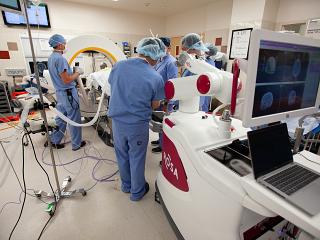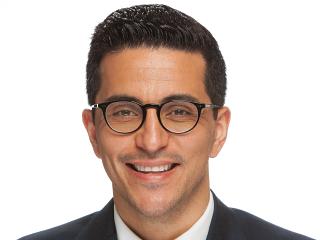
Surgical treatment of epilepsy can be a time-consuming and potentially uncomfortable process for patients.
But now, with the assistance of robotic technology, neurosurgeons at University of Utah Health are able to pinpoint the source of seizures in a minimally invasive fashion, helping patients recover and return to normal life more quickly. Introducing the benefits of robotic precision and safety to what are often long cranial procedures can be a game-changer for patients and surgeons alike, increasing operative efficiency and accuracy.
When medications fail to control seizures, and physicians have difficulty determining which area of the brain the seizures originate from, recently adopted technologies like stereoencephalography (sEEG) provide a minimally invasive alternative that avoids open surgery. Depending on the number of electrodes needed, this process can still be time-consuming.
The robotized operating surgical assistant (ROSA), allows surgeons to do the same procedure in half the time or less
"We are excited to have access to this technology for our patients as robotic assistance improves operative efficiency and reduces the possibility of human error," said Shervin Rahimpour, MD, assistant professor of neurological surgery. He and neurosurgeons Ben Shofty, MD, PhD, and Robert Bollo, MD, are experts in robotic assisted neurosurgery.
This leading-edge device combines GPS-like mapping software with a robotic arm, providing surgeons with fast and efficient access to surgical trajectories.
Neurosurgeons can use these tools to identify seizures, pinpoint exactly where they start, and provide individualized treatment. ROSA's robotic arm replicates the movements of a human arm, allowing exceptional dexterity and flexibility.
"Utilizing ROSA for electrode placement marks an important step towards safer and less invasive surgery for localizing areas of seizure onset" said Rahimpour. "Being able to perform these surgeries, through small openings, as opposed to larger craniotomies, has led to improved patient comfort without compromising outcomes."
For surgeons, this means being able to perform seizure mapping surgeries with precision and more flexibility than conventional techniques make possible. For patients, it can mean a safer procedure, with faster recovery times and shorter hospital stays.
The addition of this new technology follows over a decade of the program as a national leader in the field of navigation-based precision brain and spine surgery. As a level 4 comprehensive epilepsy center, U of U Health is positioned to identify the best treatment for people whose epilepsy does not respond to medications.
"We treat a variety of pathologies that require neuromodulation and that entails placement of electrodes in the brain with high precision." said Rahimpour.
The Department of Neurosurgery at U of U Health also utilizes robotic assistance for other cranial procedures, including deep brain stimulation, responsive neurostimulation, biopsies, and laser interstitial thermal therapy to treat epilepsy and tumors.
Photo: Shervin Rahimpour, MD

